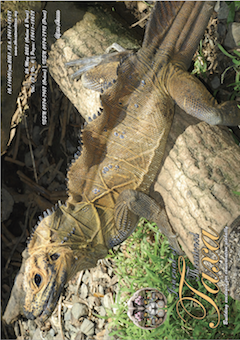A unique archetype of conservation in Himachal Pradesh, western Himalaya, India
DOI:
https://doi.org/10.11609/jott.6421.13.6.18647-18650Keywords:
Conservation, Himalaya, Praja Mandal, Sacred grove, Traditional knowledgeAbstract
Owing to numerous emerging threats to biodiversity, its conservation has been of paramount importance in today’s world. Interestingly, many modern practices have been followed globally for the conservation of natural resources, yet traditional conservation practices that could set an excellent example need to be explored worldwide. Keeping this in view, the current communication aims to highlight a unique conservation method that has been practiced in the remote and cold-arid region of the state of Himachal Pradesh in the western Himalaya. Locally known as ‘Praja Mandal’, this indigenous system of conservation needs to be addressed and adopted nationwide with an eye towards a sustainable ecosystem.
References
Anthwal, A., N. Gupta, A, Sharma, S. Anthwal & K.H. Kim (2010). Conserving biodiversity through traditional beliefs in sacred groves in Uttarakhand Himalaya, India. Resources Conservation and Recycling 54(11): 962–971.
Arora, V. (2006). The forest of symbols embodied in the Tholung Sacred Landscape of North Sikkim, India. Conservation and Society 4(1): 55–83.
Aya, D.D. & F. Waswa (2016). Role of indigenous knowledge systems in the conservation of the bio-physical environment among the Teso community in Busia County-Kenya. African Journal of Environmental Science and Technology 10(12): 467–475. https://doi.org/10.5897/ajest2016.2182
Camacho, L.D., D.T. Gevana, A.P. Carandang & S.C. Camacho (2015). Indigenous knowledge and practices for the sustainable management of Ifugao forests in Cordillera, Philippines. International Journal of Biodiversity Science, Ecosystem Services and Management 12: 1–2, 5–13. https://doi.org/10.1080/21513732.2015.1124453
Ens, E., P. Pert, P. Clarke, M. Budden, L. Clubb, B. Doran, C. Douras, J. Gaikwad, B. Gott, S. Leonard, J. Locke, J. Packer, G. Turpin & S. Wason (2015). Indigenous biocultural knowledge in ecosystem science and management: Review and insight from Australia. Biological Conservation 181: 133–149. https://doi.org/10.1016/j.biocon.2014.11.008
GOI (2011). Population totals, Series-3, Ministry of Home Affairs, Government of India, Census of India, New Delhi, India. http://www.censusindia.gov.in/2011 (accessed on 2 April 2019).
Jaryan, V., S.K. Uniyal, Gopichand, R.D. Singh, B. Lal, A. Kumar & V. Sharma (2010). Role of traditional conservation practice: highlighting the importance of Shivbari sacred grove in biodiversity conservation. Environmentalist 30(2): 101–110. https://doi.org/10.1007/s10669-009-9249-x
Kandari, L.S., V.K. Bisht, M. Bhardwaj & A.K. Thakur (2014). Conservation and management of sacred groves, myths and beliefs of tribal communities: a case study from north-India. Environmental Systems Research 3(1): 16. https://doi.org/10.1186/s40068-014-0016-8
Khumbongmayum, A.D., M.L. Khan & R.S. Tripathi (2005). Sacred groves of Manipur, North-East India: Biodiversity value, status and strategies for their conservation. Biodiversity and Conservation 14: 1541–1582. https://doi.org/10.1007/s10531-004-0530-5
Kumar, A., M. Mitra, B.S. Adhikari, & G.S. Rawat (2013). Archetype conservation in Trans Himalayan Region of Nanda Devi Biosphere Reserve, Western Himalaya. eJournal of Applied Forest Ecology 1(1): 84–86.
Mavhura, E. & S. Mushure (2019). Forest and wildlife resource-conservation efforts based on indigenous knowledge: The case of Nharira community in Chikomba district, Zimbabwe. Forest Policy and Economics 105: 83–90. https://doi.org/10.1016/j.forpol.2019.05.019
Potts, A. (2017). An urgent journey: realizing the potential of integrated nature-culture approaches to create a sustainable world. The George Wright Forum 34(2): 229–237.
Reimerson, E. (2013). Between nature and culture: exploring space for indigenous agency in the Convention on Biological Diversity. Environmental Politics 22(6): 992–1009. https://doi.org/10.1080/09644016.2012.737255
Reniko, G., P. Mogomotsi & G. Mogomotsi (2018). Integration of indigenous knowledge systems in natural resources management in Hurungwe District, Zimbabwe. International Journal of African Renaissance Studies - Multi-, Inter- And Transdisciplinarity 13(1): 96–112. https://doi.org/10.1080/18186874.2018.1475869
Roy, A.B. & R. Purohit (eds.) (2018). Indian Shield, The Himalayas: Evolution through Collision. Elsevier, Amsterdam, 398pp.
Sharma, P., A. Agnihotry & P.P. Sharma (2015). An ethno-botanical study of medicinal plants in Murari Devi and surrounding areas (Mandi District, Himachal Pradesh). Indian Forester 141(1): 68–78.
Sillitoe, P (Ed.) (2017). Indigenous knowledge, enhancing its contribution to natural resources management, CABI, United Kingdom, 272pp. https://doi.org/10.1079/9781780647050.0000
Singh, H. & P. Kumar (2017). A brief overview of vegetation of Pangi Valley: An high altitude region of northwest Himalaya. Biosciences, Biotechnology Research Asia 14(2): 625–630. https://doi.org/10.13005/bbra/2487
Downloads
Published
Versions
- 28-05-2021 (2)
- 26-05-2021 (1)
Issue
Section
License
Copyright (c) 2021 Rupali Sharma, Monika Sharma, Manisha Mathela, Himanshu Bargali, Amit Kumar

This work is licensed under a Creative Commons Attribution 4.0 International License.
Authors own the copyright to the articles published in JoTT. This is indicated explicitly in each publication. The authors grant permission to the publisher Wildlife Information Liaison Development (WILD) Society to publish the article in the Journal of Threatened Taxa. The authors recognize WILD as the original publisher, and to sell hard copies of the Journal and article to any buyer. JoTT is registered under the Creative Commons Attribution 4.0 International License (CC BY), which allows authors to retain copyright ownership. Under this license the authors allow anyone to download, cite, use the data, modify, reprint, copy and distribute provided the authors and source of publication are credited through appropriate citations (e.g., Son et al. (2016). Bats (Mammalia: Chiroptera) of the southeastern Truong Son Mountains, Quang Ngai Province, Vietnam. Journal of Threatened Taxa 8(7): 8953–8969. https://doi.org/10.11609/jott.2785.8.7.8953-8969). Users of the data do not require specific permission from the authors or the publisher.





